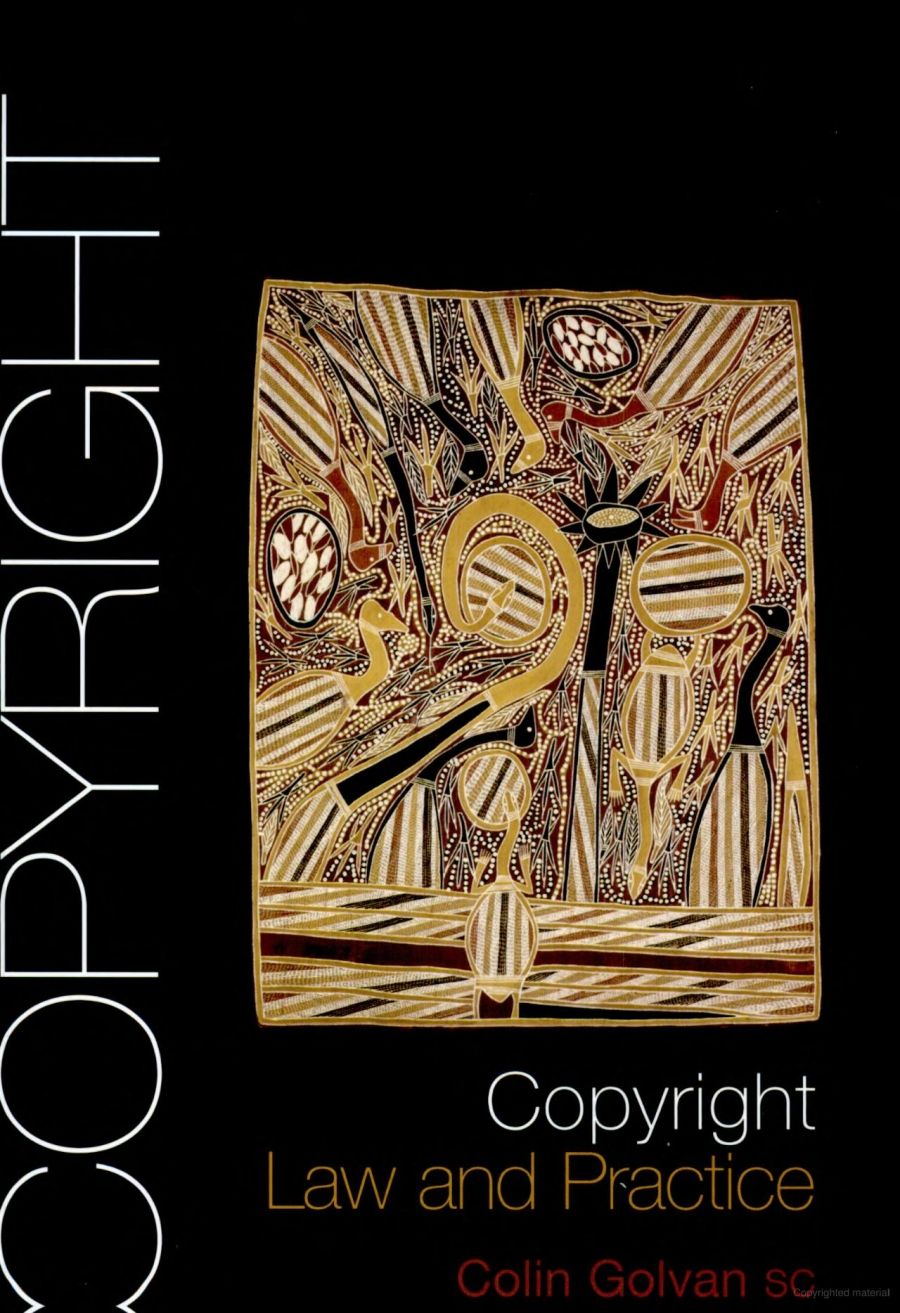
- Free Article: No
- Contents Category: Law
- Review Article: Yes
- Online Only: No
- Custom Highlight Text:
The cover design for this book features a painting by Indigenous artist Johnny Bulun Bulun. It is an appropriate choice, given that it was this artist who in 1988 spearheaded the first major action in an Australian court against the unauthorised reproduction of Aboriginal works for commercial purposes, and in so doing set a precedent in establishing the existence of copyright in Aboriginal art. The case concerned the use of works of art on T-shirts. It was followed by one against the Reserve Bank of Australia, which had reproduced an Aboriginal image on the bicentennial $10 note without permission, and the famous ‘carpets case’ against a company that imported carpets made in Vietnam that contained some well-known Aboriginal artworks in their design.
- Book 1 Title: Copyright Law and Practice
- Book 1 Biblio: Federation Press, $49.95 pb, 228 pp
- Book 1 Readings Link: booktopia.kh4ffx.net/MXYG4o
Colin Golvan is well placed to write about these events. During the 1990s he played a crucial role in several of the most important copyright cases involving Aboriginal art, though modesty restrains him from mentioning this in the book. But his close involvement with the cause of justice for Aboriginal artists makes his account of the protection of Indigenous copyright particularly fascinating. The task for the courts, and for one or two enlightened judges, has been to find ways in which Western legal rights under copyright can be reconciled with customary law that enshrines and protects the cultural rights of Aboriginal people. In particular, the problem arises as to how a legal system based on defining individual rights can cope with communal ownership of cultural symbols and imagery. Golvan shows how the landmark actions in the courts have contributed to an evolving appreciation of Indigenous culture in legal circles, and expresses the hope that the cases have enabled the development of a ‘language of understanding’ that might have wider relevance to communications between Indigenous and non-Indigenous Australians.
The chapter on Indigenous issues is only one in what is in fact a much larger enterprise, a book that deals with the entirety of copyright law and practice in Australia. Golvan has set out to write a treatment of the field that is succinct and accessible – admirable qualities for a lawyer. The resulting volume is not exactly a textbook, though it would be ideally suited for a first course in Australian copyright law. Rather, it is an analysis of the major issues facing the legislators and administrators of intellectual property rights in this country, extensively illustrated by reference to a host of major and minor cases.
The book begins with an exposition of what copyright actually entails. It is well known that intellectual property law serves a dual function. On the one hand, it exists to ensure appropriate remuneration to creators of original artistic works – novels, plays, paintings, musical compositions, etc. – and to provide them with an incentive to continue producing new works. On the other hand, it plays an important part in guaranteeing, under appropriate conditions, the public’s right of access to these works. Striking a balance between these two objectives is a tricky problem that is much discussed in the theory of intellectual property that underlies the framing of legislation. However, despite the purity of these twin goals of copyright law, application of the law in practice is strongly influenced by economic and political considerations. For instance, Golvan notes the shift in emphasis from a concern with copyright simply as an author’s right to a focus on the exploitation of the financial potential of rights by players further down the line.
An example of political intrusion into the copyright arena is provided by the recently concluded United States–Australia Free Trade Agreement, under which the then federal government agreed to extend the term of copyright from fifty to seventy years after an author’s death. Rational argument would have suggested exactly the opposite, i.e. a reduction in the term. A shorter period would reduce the costs of access (by bringing works more quickly into the public domain) without affecting in the slightest the incentive to living artists to create new works.
After its introductory overview of the basis of copyright, the volume goes on to deal with a range of issues, including infringement and how it occurs especially in the digital age; defences, meaning the use of copyright works for legitimate reasons such as private study, or review, or photo copying for educational or government purposes; and remedies that can be sought if proven infringement has occurred. All of this is discussed in the terms of the good old Copyright Act of 1968; virtually every section of the Act, from s.1 to s.248, gets a mention somewhere along the way.
The ‘practice’ aspect of the book’s title is dealt with in chapters concerned with how copyright is handled in the court system, and with the contractual nature of publishing agreements. There is much useful information in these pages for authors and publishers alike. In a concluding chapter, Golvan draws back to look at the big picture, and returns to some fundamental issues concerning access to know ledge, the challenge of the Internet and the corporatisation of copyright. He raises, but does not answer, the question of how Australia can encourage the publication of literary works by promising or established local authors in an environment where the financial return from publishing ‘popular’ writing and international blockbuster novels dominates the marketing decisions of the big publishing houses.
Colin Golvan’s book is comprehensive and authoritative, and contains a thorough documentation of its sources in case law and statute. Although it is hardly bedside reading, the book is readily understandable to the layperson, and can be recommended as a practical guide to anyone seeking a way in to the complexities of copyright law in Australia.


Comments powered by CComment